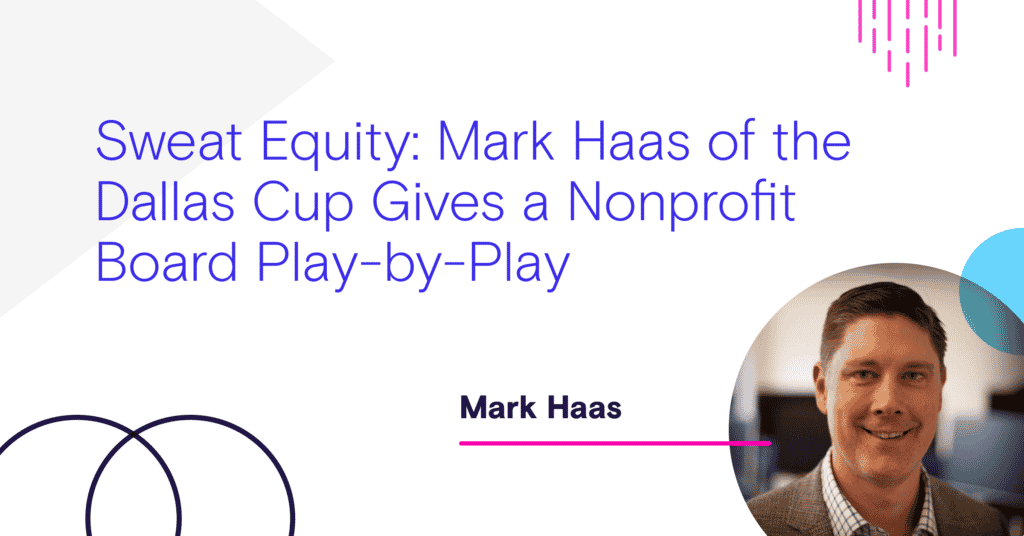
Mark Haas, treasurer of the Dallas Cup board, explains how the nonprofit soccer event board's active, hands-on approach can translate to successful nonprofit board management.
Courting sponsors, securing venues, and wrangling volunteers don’t exactly scream “board member duties.”
Yet that’s exactly the role that members of the Dallas Cup nonprofit board play each year as they use their annual soccer tournament to raise global interest and awareness of the sport.
While nonprofit board duties at first glance are wildly different than their for-profit board counterparts, the overlap is clear: The goal of all boards is to further a brand, support a CEO or executive director, and focus on finances. The only major difference? Nonprofit board members get sweat equity, while for-profit boards get real equity.
Mark Haas has been the Treasurer for the Dallas Cup board since 2012. His day job is in the sales world; previously at Tableau and SmartSheet, he’s currently the VP of Strategic Sales at Incorta.
In this conversation, Mark shares everything you need to know to be an effective nonprofit board member. With his experience keeping the 40-year-old soccer tournament thriving, he walks us through:
- Why board members are responsible for brand-building
- How to find and engage board members
- How best to collaborate with the executive director
- Why being a nonprofit board member is ultimately worth it
The Board’s Priority is to Maintain the Nonprofit Brand
According to Mark, the Dallas Cup board’s number one goal (pun intended) is to maintain the brand.
Focus on Quality
Quality, in this instance, means making sure tournaments occur in desirable venues like MoneyGram Soccer Park in Dallas, and that referee quality is top-notch. If you want to attract talented professional teams, you need a pristine and professional environment.
“Think of higher-end brands like Apple. There’s a level of focus on quality. For us, it’s really not that different,” Mark explains.
To this end, the Dallas Cup partners with various international soccer leagues and governing bodies like FIFA. The result is something truly unique: Dallas Cup is one of only a handful of large international soccer tournaments. As the only Cup of its kind in North America, the Dallas Cup is able to attract international talent. Teams from South America, North America, Europe, and Asia can all play one another.
“It’s a whole different brand of soccer, and they get to try it out,” Mark says. “That’s why these clubs want to come. They want to try their guys out against the other best-in-the-world players.”
Sell the Value of the Tournament
Ultimately, the board’s job is to strengthen that brand and sell the value of the tournament to sponsors. If it’s hard to reconcile “nonprofit” with the word “value,” just think of an equivalent event like the Boston Marathon. It’s an annual nonprofit event but, to be successful, it must be run like a true business. That one-day event needs to be maximized in order to pay for the event and its support staff.
A nonprofit tournament also isn’t much different from professional sports. “When you say the Dallas Cowboys are worth $4.5 billion, what is that based on? There are tangible things like player salaries and the stadium. But there are also intangible things,” Mark clarifies.
Promoting the Cup’s brand and value is the number one mission for Mark and his fellow board members.
To learn about other common nonprofit board duties, read an overview.
How Dallas Cup Pursues its Brand-Building Mission
So what does developing and maintaining the brand look like in practice for members of the Dallas Cup board? Mark says it comes down to 4 main pursuits: securing volunteers, stadiums, sponsors, and funding.
1. Securing Volunteers
In order to successfully execute a large tournament, you need an army of volunteers working in harmony.
The Dallas Cup employs a core staff of four individuals, but many more bodies are needed each year to make the tournament happen.
They rely on a strong partnership with the FC Dallas Youth Academy and a recurring cast of individual volunteers to pull the tournament off each year.
“We need to make sure that we work with the volunteer chair individuals and make sure that we’re meeting their needs,” Mark says.
As various requests for help come in from volunteer leads, Mark and his fellow board members must get them what they need and help attract additional volunteers.
2. Securing Venues
Professional athletes expect to play on a professional field. Everything down to the quality of the grass must be perfect so the venue matches the expectations of international all-star players.
While the Dallas Cup has existing relationships with nearby stadiums like The Cotton Bowl Stadium, a longtime Dallas football and soccer venue, and Toyota Stadium, home of FC Dallas, every so often they will need to negotiate or renegotiate stadium contracts.
3. Securing Sponsors
Sponsors are a critical part of the Dallas Cup, because revenue from the tournament alone doesn’t cover the tournament’s budget. Seeking sponsors is a constant and ongoing pursuit.
In order to secure sponsors, you need to provide value in return (see above). Mark and the board have developed a pitch deck they send to potential sponsors. It covers topics like:
- What is the Dallas Cup?
- What is the Dallas Cup brand?
- Why should you care as a company?
- How much advertising will result from website visits, social media posts, or banner ads?
The Dallas Cup gets apparel sponsored by brands like Puma and Adidas, and partnered with TV broadcasters like Telemundo to promote international exposure. Last year, ESPN+ broadcast the final weekend matches.
“This year we partnered with Coca-Cola. So we’re having to go out and have conversations with Coke’s marketing department,” Mark says.
Being on the board involves a constant effort to try to open new doors, bring in new sponsors, and maximize connections.
4. Securing Funding
The Dallas Cup staff is responsible for putting together the annual budget that is needed to run the event. The board’s role is to help turn those dollar signs on paper into a reality.
Stadium revenue is notoriously unpredictable. The weather alone can mean the difference between a packed stadium and an empty one. And with sporting events, there’s no rescheduling.
“You can’t bank your entire thing on attendance. And that’s where the sponsorship revenue comes in,” Mark says.
In addition to securing sponsors, the board helps to create sponsor categories. This provides a sense of exclusivity for sponsors who can then be the sole sponsor for a particular category or market.
“You have to figure out for the company, where do they see benefit? If you’re doing a beverage category, for instance, do they care about the U.S. market or do they care about the Latin American market?” Mark says.
The goal is to figure out what customers a company is trying to reach, and how the Cup can help that company reach its target market.
Finding & Engaging Nonprofit Board Members
Typically, Dallas Cup board members join thanks to recommendations and connections of existing board members. Mark joined because he lived in close proximity to other board members who knew about his love of soccer.
But not everyone is a good fit for a nonprofit board. Mark says it’s not enough to just want the words “board member” on your resume—you also have to be ready to engage.
He says you need 3 key ingredients to ensure board members succeed.
1. Do Prospective Board Members Have Passion?
“First and foremost, when you have a disengaged board, it’s usually because they didn’t have passion,” Mark says. “Maybe they got on the board initially because it checked a box or was a prestige thing for them.”
While board duties can seem fulfilling at first, if you don’t have passion for the area or industry, the time required can soon start to weigh heavily on you.
This leads to disengagements; you start to resent the time spent on board duties while simultaneously feeling you are getting nothing in return. Mark says it comes down to qualifying board members upfront to ensure they have that passion.
2. Do Prospective Board Members Have Skills?
A seat on a board isn’t just a title. Collectively, a board needs to have well-rounded skill sets that meet the needs of the executive director and staff.
For the Dallas Cup board, this means having members who understand the sport well, know how to run a large event, and are comfortable coordinating with stadiums, city personnel, and sponsors.
“As you’re starting to grow the board, you also have to have a traditional business mindset like you would with a for-profit board,” Mark says.
This means seeking out potential board members who have skills like marketing experience, legal experience, and accounting experience.
As your nonprofit grows, new skill sets become necessary. When the Dallas Cup started in the 1980s, the tournament was much smaller than it is today. The skills you seek will necessarily evolve over time.
3. Does Your Board Need Clearer Bylaws?
Board member engagement also comes down to the bylaws the board sets. Good bylaws are made with an understanding of board member needs, including term limits and how often to bring on new members.
“If you’ve noticed over time that there can be burnout, recognize that. Create bylaws that set a term limit—maybe it’s six years, maybe it’s two years,” Mark says. “That way you’re bringing new people in, bringing fresh ideas in, and you’re preventing burnout.”
If a board member simply isn’t pulling their weight, the bylaws also need to provide an avenue to remove them.
When you’re well-qualified and engaged, burnout isn’t an issue. Mark himself has served on the Dallas Cup board for a decade.
If you’re interested in joining a nonprofit board, start here.
What Changed for Boards in 2022?
Build a Relationship With the Executive Director
While board members help grease the wheels, the key contact at a nonprofit is the executive director, who is the equivalent of the CEO for a for-profit board. The director will supply regular status updates to the board, and come to meetings with requests.
The five major responsibilities of a nonprofit Executive Director are outlined here.
The Dallas Cup recently obtained a new executive director. Just like a CEO search, they engaged a search firm and scoured their existing connections. They also conducted the interviews via a committee.
The goal? To find someone who understood their mission and was ready to take the tournament to the next level.
Provide Hands-on Support
Bringing on a new executive director means helping them get up to speed. This is where board member skill sets really come into play: The better board members understand the organization and its ecosystem, the better they can educate and serve the director.
“That’s why it’s really important that the board has an active hands-on role in a lot of these activities alongside the executive director. You can’t just be a passive ‘I’ll meet you once a quarter and I’ll give you some strategy. Good luck.’ That’s just not going to work for a nonprofit,” says Mark.
The board should ask the director what they need so they can use their networks to help provide it.
Set Clear Expectations
Just like a for-profit board, the Dallas Cup board expects the executive director to lead each meeting with financials. Start by giving the board an updated picture of how much money is in the bank, and what your budget looks like against that. Make sure everyone is on the same page about how the organization is doing, and what needs to be done.
As with any board meeting, honesty is the best policy.
“If you’ve gone over budget, call it out. Don’t try to hide it,” Mark says. “Because we literally will spend time going line item by line item, and we’ll look at those discrepancies. And there are people on the board that’ll be like, ‘Why is this over budget?’”
If the director can’t answer questions about sponsorship status and budgets, that’s where trouble starts.
“We’ve got to have everything just perfect by the time that tournament hits,” Mark says. “There are things we expect to see every single board meeting, and you (the executive director) just update us. And if you need help, don’t be afraid to ask.”
The Benefits of Being a Nonprofit Board Member
You may pay in sweat equity when you work for a nonprofit board, but also get tangible benefits in return.
For Mark, this meant being able to serve alongside distinguished fellow board members like the former VP at Frito Lay and CMO of Dr. Pepper.
“There’s a lot of folks that want to go to the for-profit side because there’s the equity side of it,” Mark explains. “But I think there’s a lot of benefit that they can get from going to a nonprofit side. They can make a big difference out there, but I think being on a nonprofit board can also position them and help them get the skills that would allow them to be better equipped for when they join a for-profit board.”
At Dallas Cup, there’s not a single board member who won’t jump to get their hands dirty. The result is a board that is progressing the game of soccer in North America—and raising awareness around the world.
If your nonprofit is thinking big, OnBoard is here to support you with the latest nonprofit board management software.
Want to fuel your startup for success? Get started with a free trial of OnBoard.
About The Author

- OnBoard Meetings
- At OnBoard, we believe board meetings should be informed, effective, and uncomplicated. That’s why we give boards and leadership teams an elegant solution that simplifies governance. With customers in higher education, nonprofit, health care systems, government, and corporate enterprise business, OnBoard is the leading board management provider.
Latest entries
 Board Management SoftwareJuly 26, 20225 Critical Board Engagement Survey Questions
Board Management SoftwareJuly 26, 20225 Critical Board Engagement Survey Questions Board Management SoftwareJuly 19, 2022What is an Advisory Council? (Overview, Roles, and Responsibilities)
Board Management SoftwareJuly 19, 2022What is an Advisory Council? (Overview, Roles, and Responsibilities) Board Management SoftwareJuly 15, 2022Balance Sheet vs. Income Statement: What’s the Difference?
Board Management SoftwareJuly 15, 2022Balance Sheet vs. Income Statement: What’s the Difference? Board Management SoftwareJuly 12, 2022Sweat Equity: Mark Haas of the Dallas Cup Board Gives a Nonprofit Play-by-Play for Success
Board Management SoftwareJuly 12, 2022Sweat Equity: Mark Haas of the Dallas Cup Board Gives a Nonprofit Play-by-Play for Success

